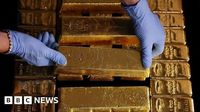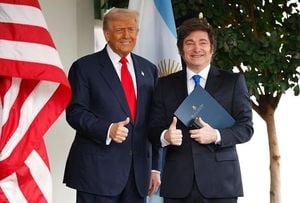Gold’s storied reputation as a safe haven asset was dramatically reaffirmed this week, as the precious metal’s price rocketed past $4,000 per troy ounce for the first time in history. The milestone, reached on October 7, 2025, sent shockwaves through global financial markets and left investors, analysts, and everyday savers scrambling to make sense of what’s fueling gold’s unprecedented ascent.
According to Reuters, U.S. gold futures for December delivery settled at $4,004.40 per ounce on Tuesday, after surging to an intraday high of $4,014.60. Spot gold, which reflects the real-time market value for immediate delivery, hovered just below that mark at $3,985.82 per ounce as of 1:48 p.m. EDT, after setting a record high of $3,990.85 earlier in the session. The Associated Press reported that the New York spot gold price had closed at $3,960.60 per troy ounce the day before, underscoring just how quickly the market has moved.
What’s behind the rush? A heady mix of economic and political uncertainty, falling interest rates, and a weakening U.S. dollar has investors searching for stability—and they’re finding it in gold. As BBC explained, gold’s rally since April 2025 has been the biggest since the 1970s, with prices rising by about a third since President Donald Trump’s latest round of tariffs rattled global trade. In fact, gold futures are up roughly 50% since the start of the year, leaping from around $2,670 in January to over $4,000 this week. Silver, not to be outdone, has soared nearly 60% year to date, trading just under $48 per ounce.
The ongoing U.S. government shutdown—now in its second week—has only intensified the sense of unease. Key economic data releases have been delayed, and federal employees are feeling the pinch of furloughs and missed paychecks. “It’s ongoing safe-haven flows stemming in part from the government shutdown and no real indication that is likely to be resolved in the immediate term here. So there’s still a pretty decent bid in gold,” said Peter Grant, vice president and senior metals strategist at Zaner Metals, in comments to Reuters.
Political turmoil isn’t limited to the U.S. Markets in France and Japan have also been rattled by recent events, adding to the global appetite for gold. According to CNBC, President Trump’s barrage of tariffs and his public threats against the Federal Reserve’s independence have further fueled uncertainty. The U.S. dollar index has dropped 10% this year, making gold—which is priced in dollars—more attractive to foreign buyers.
Central banks have played a starring role in gold’s meteoric rise. As BBC reported, central banks have collectively purchased more than 1,000 tonnes of gold annually since 2022, far outpacing the average of 481 tonnes per year between 2010 and 2021. Leading buyers last year included Poland, Turkey, India, Azerbaijan, and China. China’s central bank, for instance, added gold to its reserves for the eleventh consecutive month in September, according to data from the People’s Bank of China. This trend reflects a strategic move away from U.S. Treasuries and a desire to reduce reliance on the dollar—especially after the U.S. and its allies froze around $300 billion of Russian foreign holdings at the start of the Ukraine war in 2022.
Retail investors aren’t sitting on the sidelines, either. A record $64 billion has poured into gold-backed exchange-traded funds (ETFs) so far this year, according to the World Gold Council. Gregor Gregersen, founder of precious metals dealer Silver Bullion, told BBC he’s seen customer numbers more than double in the last year, with retail investors, banks, and wealthy families increasingly turning to gold as a long-term store of value. “Most of our clients are long-term holders,” Gregersen said. “Gold will fall at some point, but I believe given the economic environment, it’s on an upward trend for at least five years.”
Not everyone is bullish, though. Bank of America warned earlier this week of “uptrend exhaustion” in gold, suggesting that prices could face a consolidation or correction in the fourth quarter. “Gold is often seen as a hedge against uncertainty, but the hedge can be unwound,” noted Christopher Wong, rates strategist at OCBC, in comments to BBC. Prices may dip if interest rates rise or if geopolitical tensions ease. The last time the U.S. central bank raised interest rates to curb inflation—triggered by the Covid-19 pandemic in 2022—gold’s value plunged from $2,000 to $1,600 an ounce.
For now, though, expectations are firmly tilted toward lower rates. The Federal Reserve cut its key interest rate by a quarter-point in September, and markets are anticipating two more reductions before year-end. The next Fed meeting is scheduled for October 29, 2025. Lower rates make non-yielding gold more attractive compared to debt instruments like Treasury bills. Ray Dalio, founder of Bridgewater Associates, recommended on Tuesday that investors put “something like 15% of your portfolio in gold.” As Dalio put it at the Greenwich Economic Forum, “Gold is the one asset that does very well when the typical parts of your portfolio go down.”
The gold rush hasn’t been limited to financial markets. Jewelry merchants and dealers are seeing a surge in customers eager to appraise, melt, or sell family heirlooms, hoping to cash in on the precious metal’s soaring price. At the same time, shoppers in the market for new gold jewelry are feeling the sting of “sticker shock,” as rising material costs and tariffs push prices higher. Pandora CEO Alexander Lacik told investors in August, “If I’m a guessing man here, we will see a general price rise for the category.”
But the frenzy for gold has also cast a shadow. The Associated Press highlighted a troubling consequence: rising demand for mercury, a toxic metal widely used in illegal gold mining worldwide. Mercury is crucial for separating gold during artisanal or small-scale mining, but it pollutes water, accumulates in fish, and ultimately harms people, especially in countries like Senegal, Mexico, and Peru. Health officials warn of neurological and developmental risks, and even small-scale exposure can have dire consequences for workers and local residents.
Experts urge caution for anyone tempted to jump on the gold bandwagon. The Commodity Futures Trade Commission warns that precious metals can be highly volatile, and prices often rise as demand spikes—meaning “when economic anxiety or instability is high, the people who typically profit from precious metals are the sellers.” Scams and counterfeits are another risk, especially for those buying physical gold in small denominations, which often come with higher markups.
As the world watches gold’s record-breaking run, one thing is clear: uncertainty, whether economic, political, or environmental, continues to be the fuel that drives investors toward the yellow metal. Whether the rally has further to run or is due for a breather, gold’s allure as a symbol of safety and value endures—shining brighter than ever in turbulent times.





